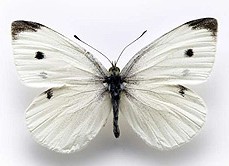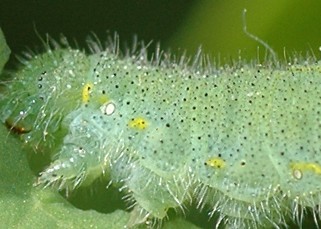 One of the most widespread and common butterflies, the small cabbage white was accidently introduced from Europe to North American via Quebec in 1860 and has spread all over the US including Hawaii. It can be found in gardens, abandoned fields, cities, plains foothills and almost anywhere except extreme climates. The butterfly is small with a wing span of 1.25 to 2.25 inches and is white with black markings. The males have one black dot on the fore wing while the females have two. The underside of the wings is yellowish green.
One of the most widespread and common butterflies, the small cabbage white was accidently introduced from Europe to North American via Quebec in 1860 and has spread all over the US including Hawaii. It can be found in gardens, abandoned fields, cities, plains foothills and almost anywhere except extreme climates. The butterfly is small with a wing span of 1.25 to 2.25 inches and is white with black markings. The males have one black dot on the fore wing while the females have two. The underside of the wings is yellowish green.
 Mating begins in early spring and gavid females deposit single yellowish vase-shaped eggs on the underside of the leaves of host plants. Bright green caterpillars with yellowish black stripes and covered with a short pile emerge in a few days and begin to feed. They grow to 3/4 “long before they pupate and form a speckled green or tan chrysalis. A single female can have three or more broods between last and first frost.
Mating begins in early spring and gavid females deposit single yellowish vase-shaped eggs on the underside of the leaves of host plants. Bright green caterpillars with yellowish black stripes and covered with a short pile emerge in a few days and begin to feed. They grow to 3/4 “long before they pupate and form a speckled green or tan chrysalis. A single female can have three or more broods between last and first frost.
The larva feed mostly on the leaves of the mustard family, Brassicaceae, that includes cabbage, kale, watercress, arugula, broccoli, radish, and brussel sprout as well as many weeds and a few garden flowers. The larva can be voracious feeders and destroy crops such as cabbage so any host plants you use to attract egg laying females might be devoured. In addition to vegetables already mentioned, the larvae like sweet alyssum (Lobularia maritime), honesty (Lunaria annua), stock (Matthiola in cana), beebalm (Cleome serrulata), nasturtium (Tropaeolum majus), and mignonette (Reseda odorata). The adults prefer purple, blue, and yellow flowers for nectaring and are especially fond of asters, mint, purple loosetrife (Lythrum salicaria), black-eyed susan (Rudbeckia spp), bird foot violet (Viola pedata), red clover ( Trifolium pretense) and dandelions.